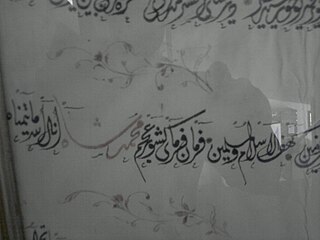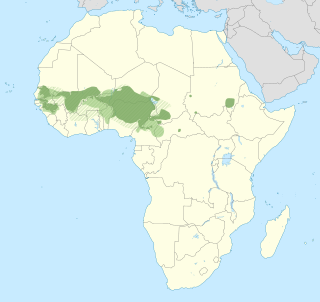Related Research Articles

Hausa is a Chadic language that is spoken by the Hausa people in the northern parts of Nigeria, Ghana, Cameroon, Benin and Togo, and the southern parts of Niger, and Chad, with significant minorities in Ivory Coast. A small number of speakers also exist in Sudan.
Yoruba is a language that is spoken in West Africa, primarily in Southwestern and Central Nigeria. It is spoken by the Yoruba people. Yoruba speakers number roughly 47 million, including about 2 million second-language speakers. As a pluricentric language, it is primarily spoken in a dialectal area spanning Nigeria, Benin, and Togo with smaller migrated communities in Côte d'Ivoire, Sierra Leone and The Gambia.
Hausa–Fulani are people of mixed Hausa and Fulani origin. They are primarily found in the Northern region of Nigeria, most of whom speak a variant of Hausa or Fula or both as their first language. The term Hausa-Fulani is also used mostly as a joint term to refer to both the monoethnic Hausa and Fulani ethnic populations in Northern Nigeria.

Zarma is one of the Songhay languages. It is the leading indigenous language of the southwestern lobe of the West African nation of Niger, where the Niger River flows and the capital city, Niamey, is located. Zarma is the second-most common language in the country, after Hausa, which is spoken in south-central Niger. With over 6 million speakers, Zarma is easily the most widely spoken Songhay language.

ʿAjam is an Arabic word for a non-Arab, especially a Persian. It was historically used as a pejorative—figuratively ascribing muteness to those whose native language is not Arabic—during and after the Muslim conquest of Iran. Since the early Muslim conquests, it has been adopted in various non-Arabic languages, such as Turkish, Azerbaijani, Chechen, Kurdish, Malay, Sindhi, Urdu, Bengali, Punjabi, Kashmiri, and Swahili. Today, the terms ʿAjam and ʿAjamī continue to be used to refer to anyone or anything Iranian, particularly in the Arab countries of the Persian Gulf. Communities speaking the Persian language in the Arab world exist among the Iraqis, the Kuwaitis, and the Bahrainis, in addition to others. A number of Arabs with Iranian heritage may have the surname ʿAjamī (عجمي), which has the same meaning as the original word.

Islam is one of the two largest religions in Nigeria. Nigeria also has the largest Muslim population in Africa.In 2024, Nigeria had the largest Muslim population in Africa, with around 105 million people who belonged to an Islamic denomination. Islam is predominantly concentrated in the northern half of the country, with a significant Muslim minority existing in the southern region. Most of Northern Nigeria is governed under Sharia law, while the rest of the country is governed under secular law.

Fula, also known as Fulani or Fulah, is a Senegambian language spoken by around 36.8 million people as a set of various dialects in a continuum that stretches across some 18 countries in West and Central Africa. Along with other related languages such as Serer and Wolof, it belongs to the Atlantic geographic group within Niger–Congo, and more specifically to the Senegambian branch. Unlike most Niger-Congo languages, Fula does not have tones.
Air Tamajeq (Tayərt) is a variety of Tuareg. It is spoken by the Tuareg people inhabiting the Aïr Mountains of the Agadez Region in Niger.

The Arabic script is the writing system used for Arabic and several other languages of Asia and Africa. It is the second-most widely used alphabetic writing system in the world, the second-most widely used writing system in the world by number of countries using it, and the third-most by number of users.
Ajami or Ajamiyya, which comes from the Arabic root for 'foreign' or 'stranger', is an Arabic-derived script used for writing African languages, particularly Songhai, Mandé, Hausa and Swahili, although many other languages are also written using the script, including Mooré, Pulaar, Wolof, and Yoruba. It is an adaptation of the Arabic script to write sounds not found in Standard Arabic. Rather than adding new letters, modifications usually consist of additional dots or lines added to pre-existing letters.

The Hausa are a native ethnic group in West Africa. They speak the Hausa language, which is the second most spoken language after Arabic in the Afro-Asiatic language family. The Hausa are a culturally homogeneous people based primarily in the Sahelian and the sparse savanna areas of southern Niger and northern Nigeria respectively, numbering around 86 million people, with significant populations in Benin, Cameroon, Ivory Coast, Chad, Central African Republic, Togo, Ghana, as well as smaller populations in Sudan, Eritrea, Equatorial Guinea, Gabon, Senegal, Gambia. Predominantly Hausa-speaking communities are scattered throughout West Africa and on the traditional Hajj route north and east traversing the Sahara, with an especially large population in and around the town of Agadez. Other Hausa have also moved to large coastal cities in the region such as Lagos, Port Harcourt, Accra, Abidjan, Banjul and Cotonou as well as to parts of North Africa such as Libya over the course of the last 500 years. The Hausa traditionally live in small villages as well as in precolonial towns and cities where they grow crops, raise livestock including cattle as well as engage in trade, both local and long distance across Africa. They speak the Hausa language, an Afro-Asiatic language of the Chadic group. The Hausa aristocracy had historically developed an equestrian based culture. Still a status symbol of the traditional nobility in Hausa society, the horse still features in the Eid day celebrations, known as Ranar Sallah. Daura is the cultural center of the Hausa people. The town predates all the other major Hausa towns in tradition and culture.
The Fula language is written primarily in the Latin script, but in some areas is still written in an older Arabic script called the Ajami script or in the recently invented Adlam script.

Tawellemmet (Tawəlləmmət) is the largest of the Tuareg languages in the Berber branch of the Afroasiatic family. It is usually one of two languages classed within a language called Tamajaq, the other language being Aïr Tamajeq. Tawellemmet is the language of the Iwellemmeden Tuareg. It is spoken in Mali, Niger and parts of northern Nigeria by approximately 1.3 million people with the largest number of speakers in Niger at 829,000 people.
Alhaji Garba Shu’aibu Gashuwa is a contemporary Nigerian Hausa poet.

Abdalla Uba Adamu is a Nigerian academic, educator, publisher, filmmaker, ethnomusicologist, and media scholar. He hold double professorships in Science Education (1997) and Media and Cultural Communication (2012).

Hausa literature is any work written in the Hausa language. It includes poetry, prose, songwriting, music, and drama. Hausa literature includes folk literature, much of which has been transcribed, and provides a means of recording, preserving, and transmitting knowledge, especially in regard to social, psychological, spiritual, or political roles.
Adamawa Fulfulde is a variety of the Fula language. It is spoken mainly in Cameroon but also by significant communities residing in Nigeria, Chad, and Sudan by Fulani pastoralists across the Sahel. It is also known as Eastern Fulfulde and by various other names including Boulbe, Dzemay, Fula, Fulfulde, Mbororo, Palata, Peul etc.
Nigerian Fulfulde, also known as Hausa States Fulfulde, Fula, or Fulani is a variety of the Fula language spoken by the Fulani people in Nigeria, particularly in the Northern region of Nigeria. It belongs to the West Atlantic branch of the Niger-Congo language family. Phonologically, Nigerian Fulfulde exhibits a system of vowel harmony and a relatively simple consonant inventory, including stops, fricatives, and nasal sounds.
Hausa Ajami script refers to the practice of using the alphabet derived from Arabic script for writing of Hausa language.
Anjẹmi or Yoruba Ajami refers to the tradition and practice of writing the Yoruba language using the Arabic script, as part of the tradition among Muslims of West Africa at large, referred to as the Ajami script. These include the orthography of various Fula dialects, Hausa, Wolof, and more.
References
- ↑ Awoyale, Yiwola; Planet Phrasebooks, Lonely (2007). Africa: Lonely Planet Phrasebook. Lonely Planet. p. 79. ISBN 978-1-74059-692-3.
- ↑ Dalby, Andrew (1998). Dictionary of languages: the definitive reference to more than 400 languages . New York: Columbia University Press. pp. 242. ISBN 0-231-11568-7.
- ↑ omniglot.com
- ↑ maguzawa.dyndns.ws (Hausa-English dictionary)
- ↑ 'Boko Haram' doesn't really mean 'Western education is a sin', The Christian Science Monitor
- ↑ Newman, Paul (2013). "The Etymology of Hausa boko" (PDF). Mega-Chad Research Network / Réseau Méga-Tchad. Archived from the original (PDF) on 2014-04-27. Retrieved 2014-04-27.